Writings by Ernst Haas
On Photography
Photography is a bridge between science and art. It brings to science what it needs most, the artistic sense, and to art the proof that nothing can be imagined which cannot be matched in the counterpoints of nature. Through photography, both artist and scientist can find a common denominator in their search for the synthesis of modern vision in time, space, and structure. We can write the new chapters in a visual language whose prose and poetry will need no translation.
The camera only facilitates the taking. The photographer must do the giving in order to transform and transcend ordinary reality. The problem is to transform without deforming. He must gain intensity in form and content by bringing a subjective order into objective chaos. Living in a time of the increasing struggle of the mechanization of man, photography has become another example of this paradoxical problem of how to humanize, how to overcome a machine on which we are thoroughly dependent . . . the camera.

Ernst Haas by Adelaide de Menil, 1967
In every artist there is poetry. In every human being there is the poetic element. We know, we feel, we believe. As knowers, we are like the scientist relating through logical determination. As feelers we are like poets relating the unrelated through intuition. As believers, we are only accepting our human limitations. The artist must express the summation of his feeling, knowing, and believing through the unity of his life and work. One cannot photograph art. One can only live it in the unity of his vision, as well as in the breadth of his humanity, vitality, and understanding.
There is no formula—only man with his conscience speaking, writing, and singing in the new hieroglyphic language of light and time.
Color Theories
Beware of color theories. Theories in color photography are dangerous. The plain fact that there are so many of them proves my point. A color philosophy comes much closer to the truth. Beware of scientific color tests. They are as quickly outdated as a timetable. Their truth is short lived. Most theories are the result of an attempt to bring one’s practical experiences into a formula. There is no formula. There are only confirmations to formulas which one has already discovered oneself. I myself love to read theories without ever using them when working.
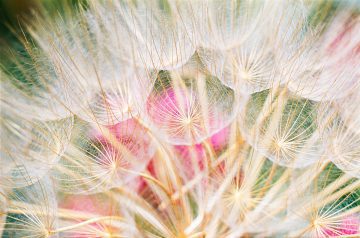
Parachute Flowers 1967
Style has no formula, but it has a secret key. It is the extension of your personality. the summation of this indefinable net of your feeling, knowledge, and experience. Take color as a totality of relations within a frame. Don’t ever overanalyze your results! Don’t ever try to find your own secret of the one which you admire. One does not try to catch soap bubbles. One enjoys them in flight and is grateful for their fluid existence. The thinner they are, the more exuberant their color scheme. Color is joy. One does not think joy. Learn by doing or even better unlearn by doing. The opposite of what you learned. The paradoxical fact in the aesthetic is that theories are also true in reverse.
Still, I don’t want to declare there are no highways of fruitful directions. In learning there are. Follow them, use them and forget them. Don’t park. Highways will get you there, but I tell you, don’t ever try to arrive. Arrival is the death of inspiration. Beware of direct inspiration. It leads too quickly to repetitions of what inspired you. Beware of too much taste as it leads to sterility. Refine your senses through the great masters of music, painting, and poetry. In short, try indirect inspirations, and everything will come by itself.
Black and White Versus Color
There have never been conflicting thoughts within me about black and white versus color photography. The change came quite naturally. I was longing for it, needed it; I was ready for it, and there was a film available to work with. The year was 1949, and the film was Kodak I, rated at 12 ASA.
I still do not understand all these problematic discussions about color versus black and white. I love both, but they do speak a different language within the same frame. Both are fascinating.
Color does not mean black and white plus color. Nor is black and white just a picture without color. Each needs a different awareness in seeing and, because of this, a different discipline. The decisive moments in black and white and color are not identical.
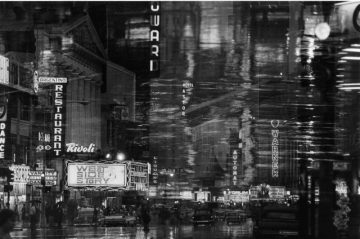
Times Square, NY 1962
There are three different factors which have to be realized and balanced: form, content, and color. The last does not always benefit the composition. It can even go against it, in which case it has to be overcome. To translate a world of color into black and white is much easier than to overcome the color, which so often runs contrary to its subject matter. There are black and white snobs, as well as color snobs. Because of their inability to use both well, they act on the defensive and create camps. We should never judge a photographer by what film he uses – only by how he uses it.
It is difficult for me to write about a problem which, for me, was just a natural evolution. I have worked for 35 years as a photographer. Al least a third of this time was in black and white, as there was nothing else. The rest has been in color, with a few unhappy years when we were asked to work in both styles.
Looking back, I think my change into color came quite psychologically. I will always remember the war years, including at least five bitter post-war years, as the black and white ones, or even better, the grey years. The grey times were over. As at the beginning of a new spring, I wanted to celebrate in color the new times, filled with new hope.
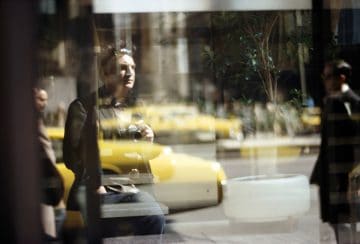
Self Portrait, NY 1971
The world wanted to be rediscovered. All sorts of magazines were born or reborn, and with them a new profession became aware of itself—the photographer. He was the new troubadour, and his instrument was the camera. With it he traveled around the world to bring back his visual songs. It was all very idealistic and often lyrical. It was also the time when veteran photographers Bob Capa, Henri Cartier-Bresson, and Chim created Magnum, the first agency owned by photographers. They were looking for new talent. Capa’s idée fixe was not so much to satisfy the banal photo market, but to create new markets. He wanted for photographers to be independent enough to work freely on their own ideas without guidance, without the need for a magazine editor and his opinion. It was a wonderful, adventurous time. We did not have much money, and we traveled like millionaires. Everything was connected with the new courage for color. Fashion, food, travel, cars, flying—everything changed and took on a new brightness. The dark ages were over. Is it any wonder then that a young photographer longed for a color film with which he could capture all this new colorfulness in the environment?
The dilemma with color is still the impossibility of doing prints as freely and easily as in black and white. If that were possible the whole so-called art market, with its incomprehensible hostility towards color, would change drastically. I sometimes ask myself, what would have happened if color film had been invented first? I loved the old black-and-white days . . . and I think of them with nostalgia.
I also still believe that the normal development of a photographer should go from black and white to color. One should be able to do both well, in the same way as painters still learn to draw as well as to paint. I first wanted to become a painter—photography came much later, and because of many strange circumstances.
Today I am happy that it happened the way it did. We live in such a fascinating world where old and new still exist side-by-side. To see a world change so fast and to be able to react visually to these changes requires a camera.
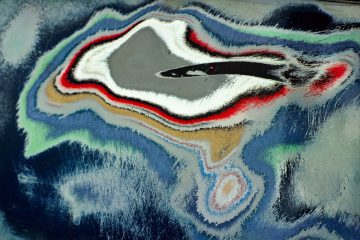
Car Scratch—Wave, Colorado 1977
A few words about the old question of whether photography is art or not. I never understood the question. If painting, music, and sculpture are arts, then even a bad painter, bad musician, or a bad sculptor must be an artist. But not a great photographer? Is it the medium or the message in question?
The pure definition of the world “art” alone is too vague today to break one’s brain and soul about it. Let us take a little vacation from this word. Let us work as well as we can, and it will come all by itself into which category it will be placed in the future. Personally, I don’t even believe so much in the value of a single picture anymore. I don’t really photograph for the wall. To compete with the painter is not really our destiny; we are on the way to speaking our very own language. With it we will have to create our own literature. you will have to decide for yourself what kind of works you want to create. Reports of facts, essays, poems—do you want to speak or to sing?
There are almost too many possibilities. Photography is in direct proportion with our time: multiple, faster, instant. Because it is so easy, it will be more difficult. We can photograph almost anything. There is a photographic explosion in the world—it’s the glamour profession. Anybody taking pictures can copy trends or styles.
Only a vision—that is what one must have.
Letter to Wilson Hicks, editor of LIFE
In response to an invitation to join LIFE as staff photographer (London, November 30, 1949):
There are two kinds of photographers—the ones who take pictures for a magazine to earn something, and the others who gain by taking pictures they are interested in. I am the second kind. I don’t believe in the in-between success of becoming famous as quickly as possible. I believe in the end-success of a man’s work as developing into a real human being, aware of the connection in life between earth and the cosmos; a person able to understand the mistakes, and to admire the achievements, of other people.
. . . I have always felt better taking a risk than an easier route for what I believe in. I am young enough to do that, and I am full of energy and hope to reach my goal. I prefer to be noticed, some day, first for my ideas and second for my good eye. . . . Maybe you will think I have not got my two feet quite on the ground. But if a photographer wants to show an overall [view], he must find a shooting point higher up. . . . What I want is to stay free, that I can carry out my ideas. . . . I don’t think there are many editors who could give me the assignments I give myself.
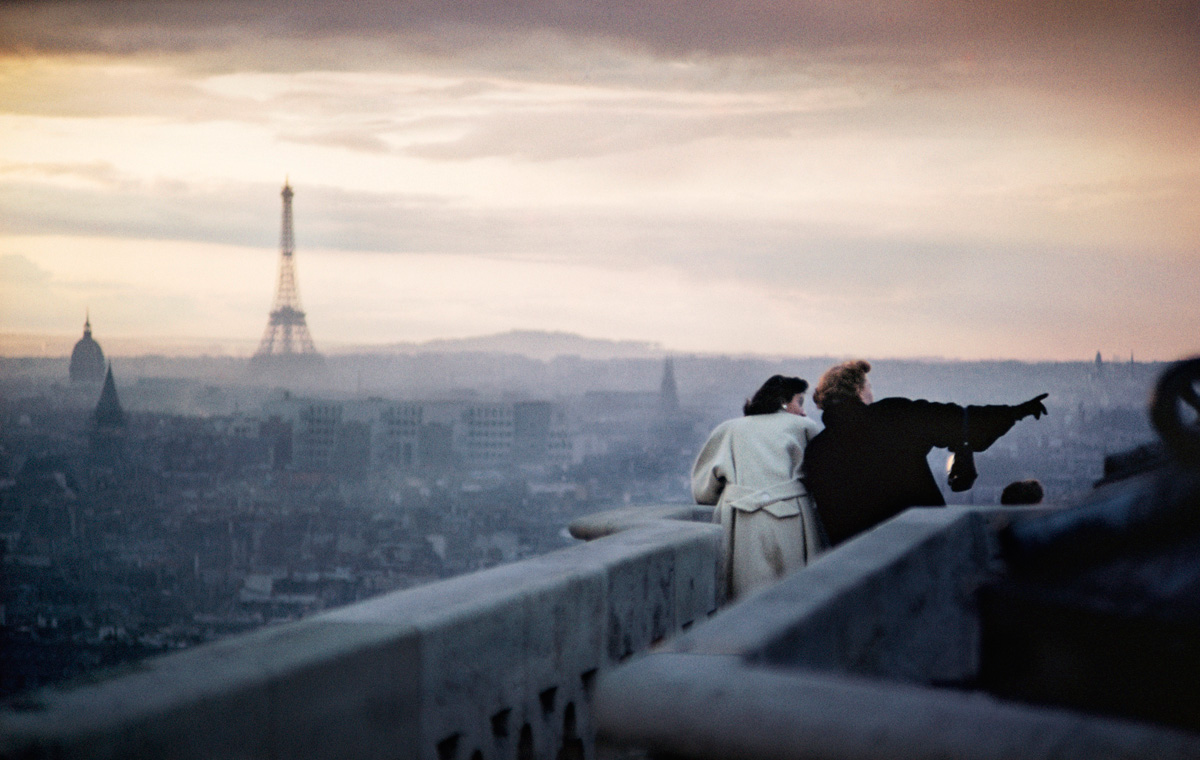
View from Notre Dame, Paris 1955
On Personal Composition
A young photographer talked to me one day about his desire to liberate himself from his own sense of composition. I understood his problem as we all would love sometimes to be free from our own knowledge. It is even the most difficult to unlearn—as the most important problems are. I advised him to photograph with his eyes closed, just using his ears for directions.
He disappeared with enthusiasm and came back with pictures which were just as well balanced in composition as his earlier work. He looked dissatisfied and asked me how I liked them. I said it is besides the point. “I just don’t see any difference in my composition,” he said. I asked him to show me the edited contact sheets. He did, and I knew the solution to his problem. Wherever he saw a well composed accident he framed it with his marking pen.
“How many rolls of film did you shoot?”
“About ten.”
“How many pictures did you edit?
“About 12.”
I asked, “Did you edit with closed eyes or open ones?” He looked at me astonished.
“With open ones!”
Here is the solution. If you photograph blind to abandon your sense of composition you have to edit the same way. It is the only way to solve your problem.
The Frame
It is the photograph’s frame that keeps the fluid border between what we want and don’t want; it also keeps the balance between values that we think we have found. We select and change through the frame with one eye, which really means that we identify ourself with the lens. We search with both eyes, but we work and correct on what we have found with one eye.
All this shall result in a picture which should again create an image effective enough to be seen and appreciated with both eyes.
The dimension of time has its own kind of frame which helps create stories as well as music.
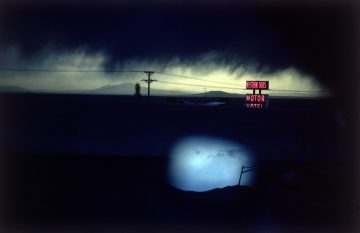
Western Skies Motel, Albuquerque, New Mexico 1977
Vision and Taste
I looked at an apple for such a long time until it became the first apple I had ever seen. I was so excited that I called a friend to tell him my experience. But how could I find the right words for what I had experienced? How could I describe my visual sensations with such literary words as red, yellow, green, shining, round? After this movement of nuances and counteractions in form and color, even in touch and smell.
Anyhow, I did not find the right words, and my friend did not believe me. So, I ate the apple, as I have eaten many an apple before. It was a fairly good apple. I called my friend again, telling him I just ate a fairly good apple, and he understood me immediately.
Conclusion: in visions we are alone, in taste we can be together. All I try is to find my inside images in the outside reality. A picture can be an answer as well as a question but if you can’t answer your question try to question your question. There are clever questions and stupid answers as well as stupid questions and clever answers. There can be questions without answers but no answers without questions. To be or not to be—that is a question. To see or not to see—that is an answer.
Artistic Longings
Ask yourself about the source in your artistic longings. Why is it so necessary that you want to do your thing? How strong is it? Would you do it if it were forbidden? Illegal, punishable? Every work of art has its necessity, find out your very own. Ask yourself if you would do it if nobody would ever see it, if you would never be compensated for it, if nobody ever wanted it. If you come to a clear “yes,” in spite of it, then go ahead and don’t doubt it anymore.
If truth is what we believe to be true, then every period, every culture has created its own truth, which has always been deeply rooted in man’s concept of the reason for existence. But in extreme situations, such as pain, love or joy, man reaches from the narrower fact of truth into the broader dimensions of poetry to express better all that he feels, sees and believes.
William Blake saw “the world in a grain of sand.” It can be seen in many such things, for in the smallest cells are reflections of the largest. And in photography, through an interplay of scales, a whole universe within a universe can be revealed.
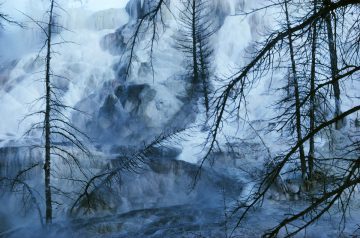
Sulfur Landscape, Yellowstone, USA 1966
The Creation
At my age, the scale of what I have done and what I still have to do is in constant movement and competition. For me, photography became a language with which I have learned to write both prose and poetry.
Whatever I did and do always became the extension of my interests. The inter- relationship of all senses and arts is very important to me. I wanted to connect photography with words through books and articles, with music through audio- visuals. In exhibitions, single pictures have to speak their pure language. I want to be open to everything in this world , and I am even willing to unlearn.
Important is the end result of your work: the opus. Therefore, I want to be remembered much more by a total vision than a few perfect single pictures.

Ernst Haas by Adelaide de Menil, 1967
